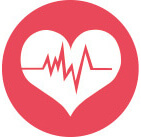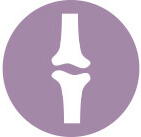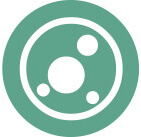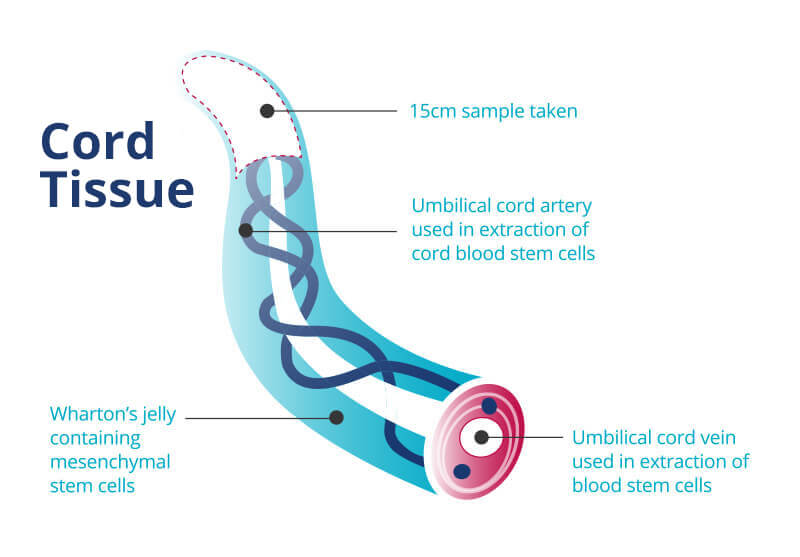Understanding Cord Tissue
A Vital Part of Cord Blood and Tissue Banking
Your baby’s umbilical cord is more than just a lifeline during pregnancy; it’s a rich source of powerful stem cells.
Umbilical cord tissue, collected along with cord blood after your baby is born, contains billions of unique stem cells, especially within the supportive “Wharton’s Jelly” that lines the cord, but also in other regions. At Cells4Life, we preserve the entirety of the umbilical cord tissue sample collected to maximize this potential.
While cord blood is rich in blood-forming stem cells, umbilical cord tissue contains several different powerful stem cell types, some of which are not found in cord blood. Opting for comprehensive cord blood and tissue banking ensures your child has access to the maximum range and variety of stem cell types. This broadens their potential to benefit from as many current and future breakthroughs in regenerative medicine as possible.
Cells4Life offers options to store your child’s cord blood and cord tissue in multiple samples, providing added security and the flexibility for potential use in multiple treatments in the future. Combining cord blood storage with umbilical cord tissue banking is a comprehensive approach to securing the maximum range and highest number of stem cells for your child.
Why Bank Both? The Advantages of Comprehensive Cord Blood and Tissue Banking
Access the Greatest Possible Number and Variety of Stem Cells
Some advanced stem cell therapies may require the maximum number of cells available to increase their chances of success. By choosing our CellsPlus™ service for your cord blood and tissue banking, you ensure your baby has access to an abundant and diverse supply. Our CellsPlus™ processing for cord blood is designed to preserve significantly more stem cells at the point of therapy compared to other standard processing technologies.
Be Prepared for a Wider Range of Future Treatments
As your child grows, the range of common conditions potentially treatable with stem cells from cord blood and tissue banking is continually expanding. Securing the maximum number and types of stem cells means your child is better prepared for potential future health needs, possibly allowing for multiple treatments throughout their life for conditions that may arise.
Key Stem Cells in Umbilical Cord Tissue
Mesenchymal Stem Cells (MSCs)
The umbilical cord itself, particularly the Wharton’s Jelly, is an abundant source of MSCs. These tissue-forming stem cells are often more plentiful and potent than those found in cord blood or adult tissues. Research highlights their immense potential in regenerative medicine, with studies showing MSCs from umbilical cord tissue could even be used in organ regeneration – one of the most exciting frontiers in medical science.
Unique Cell Types Specific to Cord Tissue
Beyond MSCs, cord tissue contains several other unique cell types with significant therapeutic promise:
Human Umbilical Vein Endothelial Cells (HUVECs)
Easily cultured, HUVECs are vital in research for vascular biology, including studies on inflammation, blood clotting, and angiogenesis (the formation of new blood vessels).
Cord Lining Epithelial Stem Cells (CLESCs)
CLESCs have shown effectiveness in treating hard-to-heal human wounds like diabetic ulcers and corneal defects. Animal studies also suggest potential for liver and heart regeneration.
Human Umbilical Cord Perivascular Cells (HUCPVCs)
These cells found around the cord’s blood vessels are being investigated for bone formation and dermal (skin) tissue engineering.
What is Umbilical Cord Tissue Being Researched For?
Stem cells from umbilical cord tissue, particularly MSCs, are currently being investigated in clinical trials for a wide array of conditions, including:
- Alzheimer’s Disease
- Aplastic Anemia
- Cardiomyopathy
- Cartilage Repair
- Cerebral Palsy
- Connective Tissue Diseases
- Type 2 Diabetes
- Erectile Dysfunction
- Liver Failure
- Multiple Sclerosis
- Myocardial Infarction (Heart Attack)
- Osteoarthritis
- Ovarian Failure
- Parkinson’s Disease
- Psoriasis
- Retinitis Pigmentosa
- Rheumatoid Arthritis
- Sepsis
- Spinal Cord Injury
- Stroke
- Traumatic Optic Neuropathy
- Ulcerative Colitis
…and many others.
Early clinical trials have shown promising results in treatments using umbilical cord tissue stem cells for the following conditions…

Neurological conditions
Scientists, including those at Duke University in North Carolina, are conducting trials using cord tissue-derived MSCs for conditions like autism.

Heart and vascular disease
Researchers have seen promising results using MSCs from cord tissue to engineer new cardiac tissue, offering hope for patients with heart failure.

Diabetes
Clinical trials are applying Wharton’s Jelly-derived MSCs from umbilical cord tissue to patients with Type 2 diabetes.

Skeletal conditions
MSCs are being investigated as an osteoarthritis treatment. Their anti-inflammatory properties could potentially reduce pain, improve joint function, and promote cartilage repair.

Cancers
Studies have indicated that umbilical cord tissue MSCs may inhibit the growth of certain cancer cells, including prostate and breast cancer.

Inflammatory & autoimmune
Researchers in Durham, North Carolina have found that MSCs can show potential in treating sepsis, an inflammatory condition.
GET YOUR FREE INFO KIT
Quick questions…
What is the procedure for collecting umbilical cord tissue after birth?
The collection process is simple, easy and safe, as well as entirely non-invasive. It happens after the third stage of labor, once the placenta has been delivered and the umbilical cord has been clamped and cut. An undamaged portion of the umbilical cord is selected, cut, and placed in our collection kit to be safely delivered back to us. If you have chosen to also bank cord blood, that collection happens first.
What is umbilical cord banking and what are its benefits?
Cord blood and cord tissue banking is the process of collecting and cryogenically freezing the blood from your baby’s umbilical cord and a segment of the cord tissue itself immediately after birth. This is a once-in-a-lifetime opportunity to preserve a rich source of powerful stem cells.
- Cord blood is a valuable source of hematopoietic stem cells (HSCs), which can develop into any type of blood cell. These cells are currently used in FDA-approved treatments for over 80 conditions, including certain cancers, blood disorders, and immune system deficiencies.
- Cord tissue contains a different type of stem cell called mesenchymal stem cells (MSCs). While research is ongoing, MSCs have shown immense potential in regenerative medicine for repairing and healing tissues, with numerous clinical trials exploring their use for conditions like heart disease, and more.
Banking your baby’s cord blood and cord tissue provides a perfect genetic match for your child, which could be used in future medical treatments. It also increases the likelihood of a suitable match for other family members.
Who can use the stored cord tissue? Is it only for my baby?
The stored stem cells are a perfect genetic match for your baby, which is why cord blood and cord tissue banking is a form of personalized medicine for your child’s future. However, the benefits can extend to your immediate family.
- Siblings: There is a 25% chance of a perfect match and a 50% chance of a partial match between siblings, making the stored cells a potential resource for a brother or sister in need.
- Other Family Members: The stored cells may even be a match for parents or family members.


